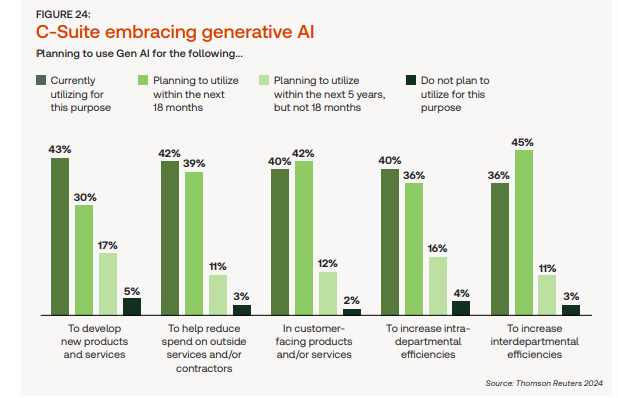Insights from the 2024 State of the Corporate Law Department Report
Law departments may have a bit of an image problem. The 2024 State of the Corporate Law Department report from Thomson Reuters found that there are some interesting disconnects between how legal departments think about their work and how the business perceives and values it.
As one general counsel notes in the report, “One of our key strategic challenges right now is to find a way to quantify the impact of our work as a benefit to the company and that it is not only seen as an expense, but that everything we do in terms of prevention can be quantified and valued… so that we can compete with the initiatives of other areas [of the business] whose economic metrics are much more direct or evident.”
The good news is you can use the data and insights to change the narrative about your department within your business. Here are three approaches to consider.
Jump to ↓
Talk about legal effectiveness and regulatory results
Use AI as an enabler of culture and engagement
Quantify the impact of your preventative risk management work
|
Mind the gap: talk about legal effectiveness and regulatory results
The report found that there’s a big gap between how legal department leaders and C-suite leaders prioritize legal effectiveness. In fact, 31% of C-suite leaders rated “quality of advice” as a high priority, while just 16% of legal professionals prioritized it.
According to the Thomson Reuters Institute, “There may well be good reasons… for these gaps…. While C-Suite executives identify ‘quality of advice’ as a priority for the legal department (and understandably so), the GC considers that to be the bare minimum of their department’s role, not a key focus.”
Legal teams have been focused on cost management and efficiency to protect their business. “We are trying to be better equipped to handle various matters as they come up and guide our internal team more efficiently,” one legal leader said in the report. Unfortunately, focusing on that efficiency work in your conversations with business partners can reinforce the idea of the legal department as a cost center.
Consider shifting how you talk about your key initiative with people outside the department. Emphasize how shifts in processes or technology support better legal outcomes and better strategic counsel for your business partner and be sure to highlight any notable successes or major costs avoided. If possible, save the efficiency talk for budget conversations.

Lead the way: Use AI as an enabler of culture and engagement
Forty-two percent of GCs in the 2024 State of the Corporate Law Department report believe that artificial intelligence (AI) will transform the legal profession. And more than half of C-suite executives have a similar mindset, reporting that “if they are not already using AI for a wide variety of functions, they will be within the next 18 months.” So even those GCs who aren’t ready to go all in on AI will need to start moving forward with it to keep up with the enterprise.
Leaning into GenAI is a massive opportunity for legal teams to deliver legal work faster – solving “quality of advice” and efficiency challenges with one motion. Plus, as the C-Suite is putting more energy into employee engagement, training, and development, GenAI can be a useful tool.
In terms of employee engagement and wellbeing, one respondent said that AI can provide a platform for people to experiment with different points of view as they shape their own viewpoint. “When we are genuinely heard and understood in our unique and genuine selves, we are more highly engaged and enabled to thrive. That all leads to massive improvements in wellbeing for an organization.”
Training and development are another priority for business leaders. One legal leader noted that “I could see AI creating test or grading test which we use to grade employees.” Another saw potential in AI “streamlining work that junior lawyers are available to support on more complex projects.”
Talking about GenAI through these frames, in addition to the efficiency argument, is a great way to show that the legal department is leading the way for the organization in areas that the C-Suite cares deeply about.

Make it count: Quantify the impact of your preventative risk management work
According to the 2024 State of the Corporate Law Department report, “Protecting the enterprise from risk, serving as a guardian of sorts, is perhaps the central function of the corporate law department, especially around implicating regulatory compliance, dispute mitigation or avoidance, and overall risk management.”
Certainly, business leaders also see protection as a core responsibility of the law department. But do your business partners understand the value you create and protect for the organization?
“It can be difficult for law departments to know how to quantify the value they provide in protecting the enterprise,” according to the Thomson Reuters institute. “One can draw parallels to under-resourced corporate tax departments that have been shown to suffer more significantly from negative events such as audits and tax penalties. Corporate law departments should consider using similar metrics to demonstrate the value of investment in the legal function.
Incorporate these metrics into conversations with your business partners. What might feel like table stakes for you will be eye opening for them and may help protect your budget in the future.
Corporate law departments are making big strides toward being seen as strategic advisors. Continuing to adjust your story to align to the priorities of your business partners can help you make this shift even more quickly. Of course you will have your key areas of focus, working hard on efficiency, cost control, and spend management. While you do so, you can tell your story in a way that focuses on areas your colleagues are passionate about – innovation, value creation, and employee engagement.
 |
 |










